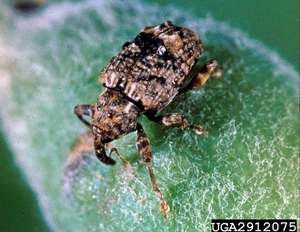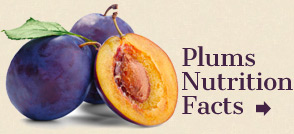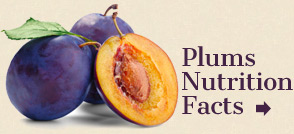Insects
Plum curculio
Adult beetles of this pest cause feeding and egg laying damage to fruit of plum and other tree fruit.Plum curculio egg laying scars in nectarine Egg laying scars are distinctive crescent-shaped and feeding holes are circular, approximately 2 to 3 mm in diameter. Adult beetles are approximately 5 mm long and have a rough-surfaced brown body and distinctive snout. The adult is easily spooked, and quickly tucks into a round ball to roll off the tree into the ground cover.
This insect tends to be a problem in orchard rows adjacent to woods, hedgerows and brush piles where the adult beetle overwinters. Plums are exposed to attack once the fruit expand enough to emerge from the protective shuck, approximately two weeks after petal fall. Egg laying by the adult female is somewhat unpredictable, but generally occurs when maximum temperatures are at least 75°F for 2-3 days or when mean daily temperatures are 55°-60°F for 3-6 days. Plum curculio egg laying can be delayed by cool and windy nighttime conditions and then become intense when conditions turn favorable. An adult female can lay 100 to 500 eggs. An off-white c-shaped segmented larvae hatches in the fruit, which Plum curculio adult: Clemson U. - USDA Coop Ext Slide Series, www.ipmimages.org may drop if the fruit is very small. Mature larvae leave the fruit, burrow into the soil and pupate, emerging as adults in August. The adults may cause feeding hole puncture wounds on fruit. Later, they return to the ground cover to hide under leaf litter or in the soil to overwinter, emerging in spring to mate, feed on immature fruit, and lay eggs. There is one generation per year in northern regions.
Plum curculio adult: Clemson U. - USDA Coop Ext Slide Series, www.ipmimages.org may drop if the fruit is very small. Mature larvae leave the fruit, burrow into the soil and pupate, emerging as adults in August. The adults may cause feeding hole puncture wounds on fruit. Later, they return to the ground cover to hide under leaf litter or in the soil to overwinter, emerging in spring to mate, feed on immature fruit, and lay eggs. There is one generation per year in northern regions.
The first 30 to 45 days after shuck split are generally the most important time for insecticide control of plum curculio and tarnished plant bug. Since damage can be quick, protective insecticide coverage is generally recommended for this time period before temperatures favorable for egg laying occur. Experience with an orchard site may help to guide strategies such as border sprays to help reduce pesticide usage.
A wide array of insecticide options are available to commercial growers for plum curculio control. See pesticide labels for current legal status and restrictions for use. Materials shown to be good to excellent include:
Organophosphate: Diazinon, Imidan
Neonicotinoid: Provado, Actara, Assail
Pyrethroid: Asana, Danitol, Baythroid, Mustang Max
Oxadiazine: Avaunt
Kaolin clay: Surround
The spinosyn product Delegate is only fair against plum curculio adults. Kaolin clay requires frequent reapplication especially under rainy conditions to maintain the repellent coverage.
Oriental fruit moth
This insect is a common tree fruit pest causing damage to fruit crops including plum. The small, darkOriental fruit moth larvae in nectarine adult moth of the Oriental fruit moth (OFM) is generally inconspicuous in the orchard. Larvae are segmented, white to slight flesh-colored with a brown head capsule and resemble codling moth larvae. The adult female emerges from overwintering sites at approximately bloom time, mates with the male, and lays eggs near or on developing fruit and young shoots. Larvae hatching from the eggs will burrow into shoot tips or developing fruit. Unlike oblique banded leaf roller larvae which are surface feeders, OFM larvae tunnel deeply into fruit, leaving a trail of brown, sawdust-like frass (excrement). Larvae can emerge and burrow into another fruit, eventually emerging to pupate and develop into an adult moth. There can be 3 generations per year.
Insecticide strategies for management are aimed at protecting fruit from larvae entry. The timing for coverage can be guided by the use of models for predicting OFM development, which is further fine-tuned with the use of pheromone traps to detect OFM moth first emergence and population levels. Michigan and Wisconsin growers can access an online OFM model at the web site Enviroweather.msu.edu.
Pheromone disruption is a generally effective technique for OFM control if used correctly. Dispensers that emit synthetic OFM female sex attractant hormone are put in the orchard, resulting in a “cloud” of scent that confuses the male seeking a potential mate.
Oblique-banded leafroller
This insect is a common pest of many crops. There are two complete generations of oblique-bandedOblique banded leafroller larvae leafroller (OBLR) per year in Michigan. Overwintering larvae feed inside bud clusters prior to bloom, begin feeding on fruit after petal fall, and mature in late May and June. The summer generation of larvae is the one that may cause fruit damage, and is generally active from about late June into August. A degree day model can be used to predict larval activity periods. Michigan and Wisconsin growers can access an online OBLR model at the web site Enviroweather.msu.edu.
Pheromone traps that attract male moths can be used to help predict when egg laying and hatch of the summer generation will occur. Traps are not as useful to indicate the size of the insect population for a particular orchard because the traps draw the moths from long distances.
Routine insecticides aimed at egg laying or hatching times is one strategy. Since the insect is an occasional pest that roams relatively long distances, monitoring for larvae in the foliage and feeding on fruit is a good idea as part of the management program.
OBLR has developed resistance to organophosphate insecticides such as Imidan and Guthion in some orchards, so monitoring for insect populations is important when using these types of materials. Other materials labeled for OBLR in some states include pyrethroids, Intrepid, Delegate, Altacor, Belt, Rimon, and various combination (more than 1 active ingredient) products. See pesticide labels for current legal status and restrictions for use.
San Jose Scale
This insect can be a problem on all tree fruit. Infestations on tree limbs can cause trees to decline andSan Jose scale on tree limb die within 2 to 3 years if unchecked. Scales on fruit causes unsightly conspicuous red-purple spots and reduced shelf life.
San Jose scale (SJS) adult males emerge from under scales (approximately 2 mm diameter) in the spring at or slightly after plum bloom time. They then find female scales and mate. The females produce live crawlers 4 to 6 weeks later. The tiny yellow crawlers move to new sites, and deposit a protective cover. There are two, sometimes three generations per year, depending on the seasonal temperature.
Management options include oil sprays, sometimes with added insecticides such as Lorsban or Esteem at the delayed dormant stage against the overwintering scales and/or insecticidal sprays aimed at the crawler stages. Timing of sprays against the crawlers is helped with the use of white sticky traps looking for the adult male emergence in the spring or with black electricians tape, sticky side outward, on infested limbs looking for the pinpoint sized yellow crawlers.
A growing degree day (DD) base of 51 degrees Fahrenheit is used for San Jose scale, with approximately 2,503 degree days accumulated from January 1 to see male emergence. Crawlers for this generation are expected 400 to 450 DD base 51F after this biofix, which is 2,903 to 2,953 DD base 51 F from January 1. Sprays against the crawlers are most effective when directed against the first generation, which generally occurs in early to mid June. The 2nd generation of crawlers typically occurs in early to mid August in southern Michigan. A 3rd of crawlers can occur in late September to early October in hot years. Careful choice of insecticides is needed to make sure that the required time period between last application and harvest is done.




